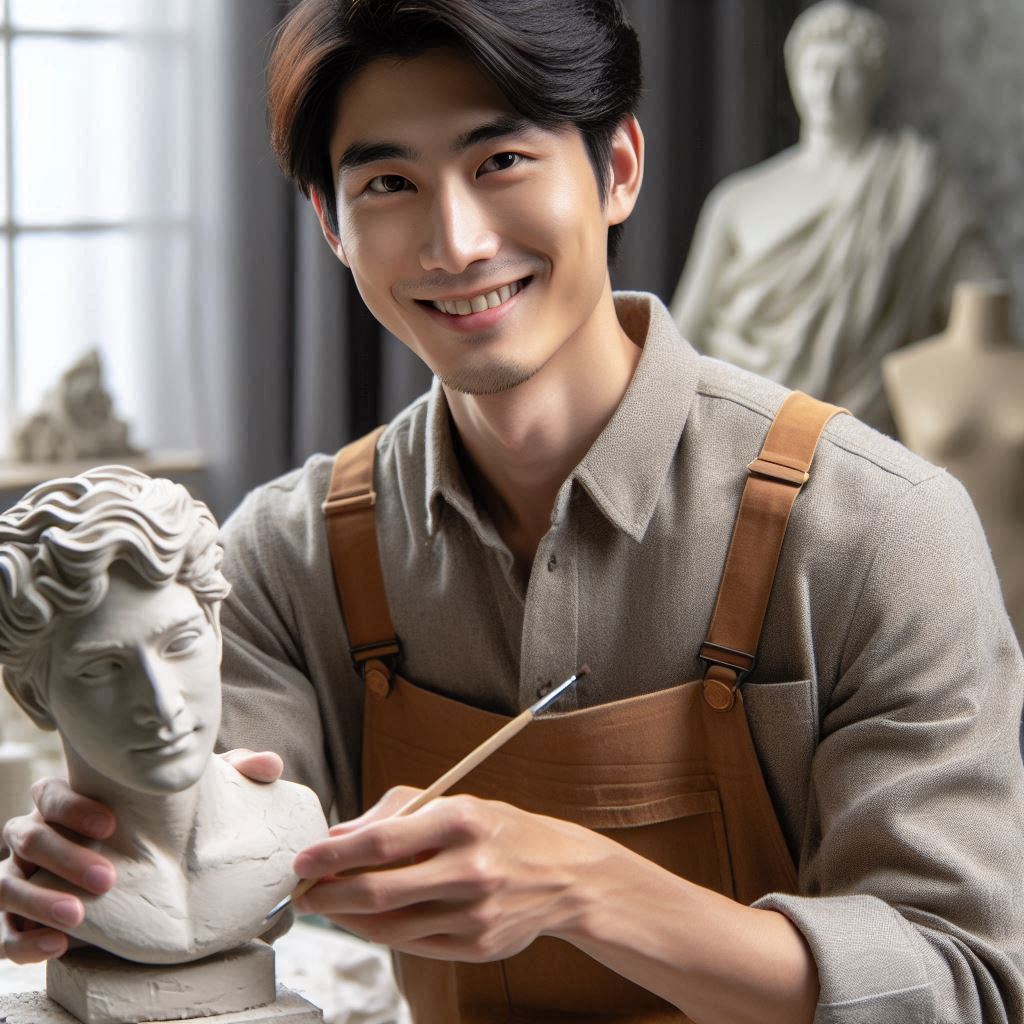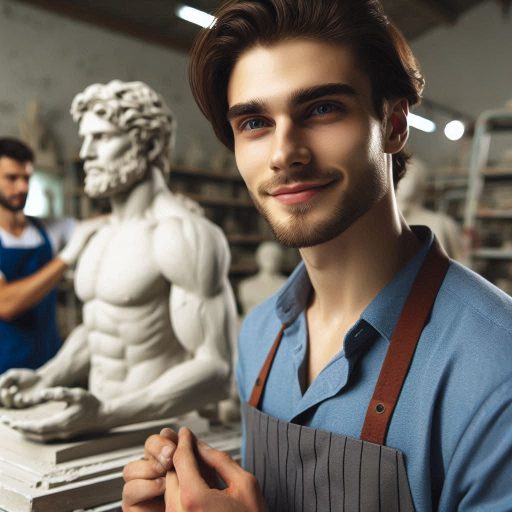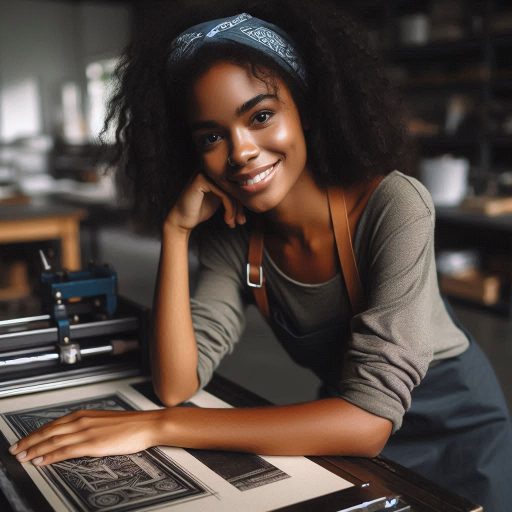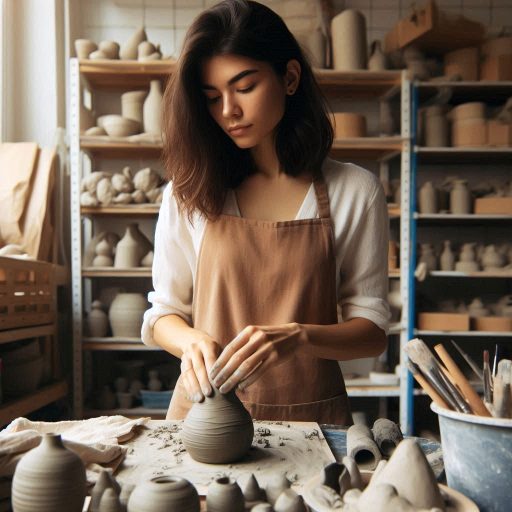Introduction
Art exhibitions offer sculptors a valuable opportunity to display their work to a broader audience.
They create a platform for artists to connect with the public, collectors, and other professionals in the art world.
Exhibiting sculptures helps artists gain visibility and build their reputation within the creative community.
Sculptors often invest significant time and energy into perfecting their craft, and exhibitions provide a chance to highlight their efforts.
Showcasing sculpture work in exhibitions is crucial for career growth.
It allows sculptors to present their artistic vision and creative abilities in a physical, tangible form.
Sculpture, unlike two-dimensional art, occupies space and interacts with the environment, making exhibitions the perfect medium to showcase its full potential.
Through exhibitions, sculptors can convey emotions, stories, and concepts in ways that engage the viewer on multiple levels.
Participating in exhibitions also offers networking opportunities.
Artists can meet gallery owners, curators, and fellow artists who may help advance their careers.
Sculptors who showcase their work can receive feedback, which can inspire new ideas or improve techniques.
Art exhibitions help artists establish credibility and gain recognition, which often leads to commissions or future exhibition invitations.
For emerging sculptors, participating in local or regional exhibitions builds a strong portfolio and attracts new audiences.
Established sculptors benefit by reinforcing their brand and connecting with loyal collectors.
In any case, showcasing sculpture work in exhibitions remains an essential step for sculptors seeking to make a lasting impact in the art world.
Exhibitions act as gateways to success, growth, and creative fulfillment.
Researching the Right Art Exhibition
Choosing the right art exhibition for your sculpture work is crucial to your success.
Not every exhibition aligns with your style or goals.
Researching ensures your work is showcased to the right audience.
A well-matched exhibition can significantly enhance your reputation and opportunities.
Transform Your Career Today
Unlock a personalized career strategy that drives real results. Get tailored advice and a roadmap designed just for you.
Start NowStart by identifying exhibitions that focus on sculpture or contemporary art.
These platforms give your work the attention it deserves.
Participating in exhibitions with themes related to your sculpture style also boosts your chances of connecting with the right collectors.
The importance of researching and choosing the right art exhibition for your sculpture work
Consider the reputation and reach of the exhibition.
Some exhibitions attract influential curators, critics, and collectors
Showcasing your work at these prestigious venues increases visibility and career opportunities.
However, smaller, local exhibitions can also be valuable for building relationships and gaining experience.
Search online databases, such as ArtDeadline and Art Show, to find upcoming exhibitions.
Explore museum, gallery, and art fair websites for open calls.
Social media is another tool for discovering exhibitions, as many galleries promote their events online.
Reach out to other sculptors and artists for recommendations.
Artists with experience in exhibitions can guide you to suitable opportunities.
Additionally, attending exhibitions yourself helps you assess the type of artwork showcased and the audience attending.
Tips on how to find and select suitable art exhibitions
When selecting an exhibition, review the submission guidelines carefully.
Ensure your work fits the exhibition‘s requirements in size, medium, and theme.
Failure to meet guidelines can disqualify your application.
In summary, thorough research is essential to finding the right exhibition for your sculpture work.
Selecting the best fit increases your chances of showcasing your art to the right audience and advancing your career.
Read: Interview Tips for Aspiring Sculptors and Designers
Preparing Your Sculpture Work for Exhibition
The necessary steps to prepare your sculpture work for exhibition, including cleaning, repairing, and packaging
Exhibiting your sculpture requires careful preparation to ensure your work looks its best.
Transform Your Career Today
Unlock a personalized career strategy that drives real results. Get tailored advice and a roadmap designed just for you.
Start NowBegin by thoroughly cleaning each piece.
Dust, grime, and fingerprints can detract from the beauty of your sculpture.
Use gentle cleaning methods that are safe for the materials, ensuring the surface remains undamaged.
Next, inspect your sculptures for any damage or imperfections.
If you notice cracks or chips, consider repairing them before the exhibition.
Small repairs can significantly improve the appearance and longevity of your work.
For more complex restoration, consult a professional to avoid further damage.
Packaging your sculpture for transportation is essential to prevent damage during transit.
Use protective materials such as foam, bubble wrap, or custom crates to safeguard your pieces.
Label each package clearly to assist in easy handling and unpacking at the exhibition venue.
The importance of presentation and display in showcasing your work effectively
The presentation of your sculpture is crucial for capturing the audience’s attention.
Choose a display method that complements the work and enhances its visual appeal.
Consider using pedestals, stands, or mounting systems that match the scale and style of your sculptures.
Ensure that the display height allows viewers to appreciate the details and craftsmanship.
Lighting plays an important role in showcasing your sculpture.
Position lights to emphasize the contours, textures, and shadows of your work.
Proper lighting creates depth and drama, enhancing the overall visual experience.
In fact, preparing your sculpture for exhibition involves cleaning, repairing, careful packaging, and thoughtful presentation.
These steps ensure your work is displayed effectively, leaving a lasting impression on viewers.
Taking the time to prepare each piece allows your artistic vision to shine through, making the exhibition a success.
Transform Your Career Today
Unlock a personalized career strategy that drives real results. Get tailored advice and a roadmap designed just for you.
Start NowRead: Printmaking Inspirations: Nature and Landscape

Marketing and Promoting Your Sculpture Work
Different marketing strategies for promoting your sculpture work before the exhibition
Promoting your sculpture work effectively can greatly enhance visibility before any exhibition.
Begin by exploring different marketing strategies.
Creating a strong personal brand is essential.
Develop a portfolio that showcases your unique style and craftsmanship.
Focus on engaging storytelling, emphasizing what sets your work apart from others.
Utilize professional photography or videos to capture the essence of each piece.
Next, leverage social media and online platforms to broaden your audience.
Post consistently on platforms like Instagram, Facebook, and Pinterest to build engagement.
Share behind-the-scenes content, from the creation process to exhibition preparation.
Engaging content helps followers connect with your journey as an artist.
Additionally, use hashtags relevant to art, sculpture, and exhibitions to increase discoverability.
Interact with followers by responding to comments, liking their posts, and sharing relevant content.
This builds a sense of community around your work and keeps your audience engaged.
Tips on using social media, online platforms, and networking to reach a wider audience
Networking is another vital tool for promotion.
Attend art events, exhibitions, and workshops to meet other artists, collectors, and gallery owners.
Form meaningful connections by discussing your creative process and sharing your artistic vision.
Always carry business cards or a digital portfolio to leave a lasting impression.
Collaborating with other artists or galleries can also help expand your reach.
Joint exhibitions or partnerships with local galleries can increase exposure and credibility.
Transform Your Career Today
Unlock a personalized career strategy that drives real results. Get tailored advice and a roadmap designed just for you.
Start NowAdditionally, reach out to art bloggers, influencers, and media outlets for coverage and features about your work.
In short, by utilizing a combination of marketing strategies, online platforms, and networking, you can effectively promote your sculpture work.
These efforts will ensure a wider audience and a successful exhibition experience.
Read: Choosing the Right Paper for Printmaking
Setting Up Your Exhibition Space
The importance of planning and organizing your exhibition space to showcase your sculpture work effectively
Organizing an exhibition space is key to presenting your sculpture work effectively.
Thoughtful planning ensures each piece is seen and appreciated in its best light.
The space should enhance the sculptures, drawing viewers’ attention to details while creating an immersive experience.
Tips on lighting, positioning, and layout for optimal display
Lighting plays a crucial role in highlighting your sculptures.
Use soft lighting to accentuate textures and shapes.
Avoid harsh, direct light that creates sharp shadows or glares.
Adjust the lighting for different angles to ensure your sculptures are viewed as intended.
Positioning your sculptures strategically is equally important.
Place larger pieces in open spaces to allow viewers to move around them.
Ensure smaller works aren‘t overshadowed and get enough focus.
Group related sculptures together for thematic coherence or create contrast by placing them apart.
The layout of your exhibition space affects the flow of the audience.
Arrange sculptures to guide viewers naturally through the exhibit.
Avoid overcrowding the space, which can make it difficult to appreciate individual pieces.
Instead, give each work ample breathing room, allowing for a clear, uninterrupted view.
Consider the height of your displays.
Transform Your Career Today
Unlock a personalized career strategy that drives real results. Get tailored advice and a roadmap designed just for you.
Start NowEye-level placement offers the best visibility, especially for detailed sculptures.
For larger pieces, consider using pedestals to elevate them for better visibility.
Balance the display with sufficient space for viewers to step back and admire the work from different perspectives.
In essence, a well-planned exhibition space enhances the viewer’s experience, making your sculptures shine.
Proper lighting, positioning, and layout create an engaging environment that showcases your work at its best.
Read: Sculpture Materials: A Guide to Choosing the Best
Find Out More: Best Books to Read for Aspiring Product Designers
Engaging with Visitors and Art Collectors
The significance of engaging with visitors and potential art collectors during the exhibition
Engaging with visitors and potential art collectors during an exhibition is crucial for sculptors.
Personal interactions can build lasting impressions and open doors to opportunities.
Exhibitions are not just about displaying art but also about forming relationships with people who appreciate it.
Sculptors who connect with their audience leave a lasting impact, enhancing their work’s appeal and value.
To make the most of these interactions, sculptors should engage visitors in conversation.
Begin by greeting them warmly and showing genuine interest in their thoughts about your sculptures.
A friendly approach encourages people to ask questions and express opinions, making the experience more memorable.
Visitors enjoy learning about the inspiration and process behind each piece, so be prepared to share details about your work.
Tips on how to communicate with audiences, answer questions, and build connections
When talking to potential art collectors, it’s essential to listen actively.
Understand their preferences and interests before discussing your sculptures.
Tailor your conversation to highlight aspects of your work that align with their tastes.
By doing this, you create a personalized experience that can foster deeper connections.
Additionally, answering questions thoughtfully and with enthusiasm can further pique their interest.
Transform Your Career Today
Unlock a personalized career strategy that drives real results. Get tailored advice and a roadmap designed just for you.
Start NowExplain your techniques and creative process clearly, avoiding overly technical jargon.
This not only helps visitors appreciate your work but also builds trust and rapport.
Building connections with visitors and collectors doesn‘t end at the exhibition.
Collect business cards, share your contact information, and invite them to follow your journey on social media.
Staying in touch after the event strengthens relationships and increases the chances of future collaborations or sales.
In summary, engaging with visitors and collectors at exhibitions is vital.
Effective communication, genuine interest, and follow-up efforts help sculptors build connections that can enhance their career.
Explore Further: Interview Tips for Landing a Concept Artist Job
Handling Sales and Inquiries at Art Exhibitions
Managing sales and inquiries at art exhibitions requires clear communication and a professional approach.
Visitors often inquire about the artist‘s background, creative process, or specific details of the sculptures.
Ensure you provide concise and informative responses to engage potential buyers.
Listen attentively to their questions and respond confidently, showcasing your knowledge of your work.
Establishing a friendly rapport can also create a comfortable environment for potential buyers to explore purchasing options.
Handling Sales, Inquiries, and Negotiations
During the exhibition, be prepared to negotiate prices and answer inquiries about your sculptures.
Stay polite and patient throughout the negotiation process, as some visitors may want to discuss pricing or additional details.
Ensure your terms are clear and fair to maintain professionalism.
Remain flexible but confident, knowing the value of your artwork.
A respectful, well-handled negotiation often results in successful sales and satisfied clients.
Guidance on Pricing, Commissions, and Managing Transactions
Accurately pricing your sculpture work is essential to attract potential buyers while maintaining profitability.
Consider material costs, time spent, and market demand when determining prices.
Transform Your Career Today
Unlock a personalized career strategy that drives real results. Get tailored advice and a roadmap designed just for you.
Start NowBe transparent when discussing commissions, especially if galleries or agents are involved.
Establish upfront how commissions will be calculated to avoid confusion later.
Ensure transactions run smoothly by offering convenient payment options, including credit card, online payments, or cash.
Keep records of all sales and issue receipts promptly to maintain professionalism.
Organizing sales efficiently helps build trust and encourages future purchases.
By handling inquiries, negotiations, and transactions with care, you create a positive experience for buyers, increasing the likelihood of repeat business.
You Might Also Like: The Role of Typography in Web Design
Conclusion
Showcasing your sculpture work in art exhibitions can greatly benefit your career as an artist.
These events provide a platform for you to display your creations and attract potential buyers and collectors.
By participating in art exhibitions, you can increase your visibility in the art world and establish connections with other artists and art enthusiasts.
These opportunities can lead to collaborations, commissions, and even gallery representation.
Art exhibitions offer a valuable chance to promote and sell your artwork, as well as receive feedback from a diverse audience.
Embrace these opportunities with enthusiasm and make the most out of each exhibition by presenting your sculpture work in a creative and engaging manner.
Remember to network with other artists, art professionals, and collectors to expand your reach and create lasting relationships in the art community.
Art exhibitions are an essential part of an artist’s journey, providing a platform for growth, recognition, and success.
Take advantage of these events to showcase your talent, share your unique voice, and contribute to the vibrant world of contemporary art.
Embrace the opportunities that art exhibitions offer and continue to create, inspire, and innovate in your sculpture practice.
[E-Books for Sale]
The Big Book of 500 High-Paying Jobs in America: Unlock Your Earning Potential
$19.99 • 500 High-Paying Jobs • 330 pages
Explore 500 high-paying jobs in America and learn how to boost your career, earn more, and achieve success!
See All 500 High-Paying Jobs of this E-Book
1001 Professions Without a Degree: High-Paying American Jobs You Can Start Now
$19.99 • 1001 Professions Without a Degree • 174 pages
Discover 1001 high-paying jobs without a degree! Unlock career tips, skills, and success strategies for just $19.99!




